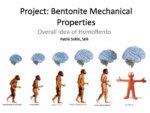BEACON: Bentonite Mechanical Evolution
Bentonite is a key component in many geological repositories. The objective of the BEACON project was to develop and test the tools necessary for assessment of the hydro-mechanical evolution of an installed bentonite barrier and its resulting performance.
Overview
Project Dates: 1/6/2017 – 01/05/2022
Project Status: Finished
Project Website: www.beacon-h2020.eu
The assessment of long-term safety of a geological repository has to rely on a robust model of a spatial and temporal distribution of the safety-relevant properties of bentonite. Thus, developing predictive capabilities for the mechanical behaviour of bentonite buffers, seals and backfills is a common need for all radioactive waste management programs that use bentonite in one or more engineered barrier system (EBS) components.
The overall objective of the Beacon project was to develop and test the tools necessary for the assessment of the hydro-mechanical evolution of an installed bentonite barrier and its resulting performance. This was achieved by cooperation between design and engineering, science and performance assessment. Because of the complexity of the objectives, networking at the European level was recognised as key for the development of integrated system understanding, skills, training and capabilities.
The evolution from an installed engineered system to a fully functioning barrier was assessed. One of the challenges recognised was the need to take into account initial heterogeneities introduced in the system by conception with a combination of block and pellets or due to the size of the bentonite component (several 100 m3). The Beacon project developed a more detailed understanding of material properties, of the fundamental processes that lead to homogenisation, of the role of scale effects and improved the capabilities of numerical modelling. This enables a scientifically justified treatment of the involved processes in subsequent safety assessments and licence applications for nuclear waste repositories.
BEACON was a collaborative project funded by the European Commission under the EURATOM Horizon 2020 Framework. The project had 25 partners from 11 countries.
Objective
In earlier assessments of the long-term performance of bentonite EBS, the mechanical evolution of the installed bentonite was neglected and an “ideal” final state was optimistically assumed. The Beacon project was undertaken in the context of several European national programs moving towards licensing, construction and operation of repositories, rendering this assumption no longer sufficient. In order to verify the performance of current designs for buffers, backfills, seals and plugs the project’s objectives were to develop the following:
- A well-documented and communicated collection of the available knowledge prior to the project.
- Re-evaluation of a large part of the existing database to extract the important information, to compile the qualitative and quantitative observations and to develop conceptual understanding.
- Enhanced, robust and practical numerical tools, firmly grounded on a good conceptual understanding, that have the required predictive capabilities concerning the behaviour of engineered barriers and seals.
- A complete experimental database to meet the need of the assessment models.
- Verified models based on experimental results from experiments at different scales.
- Workshops dedicated to bentonite mechanical issues open to the scientific community.
The Beacon project was developed to meet the pan-European aims of building confidence amongst regulators and stakeholders regarding the performance of safety barriers in a geological repository. The overall goal of the project was to verify the performance of existing designs for buffers, backfills, seals and plugs. The project was able to efficiently develop understanding regarding bentonite behaviour by working in a collaborative manner, and by pooling of information and resources.
The project was divided into a number of work packages as follows:
- Work Package 1: Define a set of real assessment cases to apply the developed models to and to thereby develop requirements on these systems that enable them to fulfil safety functions.
- Work Package 2: Collect and synthesise existing data on relevant experiments into a form usable for the project, including both laboratory and Underground Research Laboratory (URL) experiments.
- Work Package 3: Improve both the conceptual approaches and the numerical solutions used in models of the mechanical evolution of bentonite.
- Work Package 4: Undertake an experimental programme to support model development and testing in areas where fundamental data and the understanding of materials are incomplete.
- Work Package 5: To test and verify the developed models using available data of laboratory tests and then large-scale experiments.
- Work Package 6: Give civil society the opportunity to follow, discuss and give feedback on the research conducted in the project, primarily through engagement with environmental NGOs.
- Work Package 7: Undertake dissemination and training activities.
- Work Package 8: To coordinate and manage the project.
Results
The Beacon Project was important for the development of understanding of the mechanical evolution of bentonite systems. The non-technical work packages (6-8) managed the project and undertook knowledge management, training and dissemination activities. The outcomes of the technical work packages are described below.
Work Package 1
The main outcome of Work Package 1 was the selection and definition of three assessment cases at the outset of the project. The three assessment cases were:
- the Andra tunnel plug
- the Nagra disposal cell
- the KBS-3 deposition tunnel backfill
These cases were representative of the primary areas of uncertainty in density homogeneity and cover a broad range of issues; the results should also be applicable to other concepts and systems.
Work Package 2
Work package 2 of the project developed a database of bentonite experiments which collated available experimental information that could help advance understanding of the mechanical behaviour of bentonite. The database was designed and populated as a collaborative effort between the participants of the Beacon project. The database was composed of experiments at a range of scales (from bench top laboratory experiments to full scale field experiments), a number of which were designed specifically for studies of bentonite homogenisation.
Work Package 3
Work Package 3 developed a range of constitutive models to address areas of deficiency in the modelling of the mechanical evolution of bentonite. The models encompass a wide range of approaches and can deal with an extensive combination of simulation conditions. It was found that the models are able to reproduce key features of the behaviour underlying the homogenization processes such as stress path dependency and strain irreversibility among others. The conceptual bases, mathematical description and capabilities of the models were reported as part of the Work Package.
Work Package 4
Work Package 4 undertook a range of laboratory experiments to provide input data and parameters for development and validation of models and to reduce uncertainties about conditions and phenomena influencing bentonite homogenisation. The homogenisation of an initially inhomogeneous bentonite system and the persistence or development of inhomogeneities in a bentonite system under various mechanical and hydraulic conditions were investigated. In addition to the laboratory work, natural analogues were studied to develop conclusions about the evolution of bentonite systems in the long-term. The findings demonstrated that unsaturated inhomogeneous bentonite systems tend to evolve to more homogeneous systems; in particular, bentonite exhibits an extremely well gap filling behaviour. Hydration velocity was identified as a key parameter affecting the homogenisation, with fast hydration resulting in irreversible swelling close to the hydration front, resulting in an overall inhomogeneous density.
Work Package 5
Work Package 5 concerned the testing and verification of the models developed in Work Package 3 against the assessment cases complied in Work Package 1, a subset of historical and contemporary experiments collated in Work Package 2 and the experiments undertaken within the project in Work Package 4. The complexity and size of the modelled experiments progressed though the project. The initial set of evaluated experiments consisted of small scale ‘simple’ lab experiments which enabled the areas with outstanding uncertainties to be evaluated. Three large URL experiments were selected to be studied based on the criteria of being relevant to the project partners disposal concepts, highlighting the role of heterogeneities in bentonite disposal concepts, and being well described and dismantled. The selected experiments are:
- EB – Engineered Barrier Emplacement Experiment, undertaken in a clay host rock at the Mont Terri URL.
- FEBEX – Full-scale Engineered Barrier Experiment, undertaken in a crystalline rock at the Grimsel Test Site.
- CRT – Canister Retrieval Test, undertaken in a crystalline rock at the Äspö Hard Rock Laboratory.
The large-scale tests demonstrated the progress made during the project with the developed tools able to approach the end state of the experiments despite adopting a diverse set of approaches. Work Package 5 also identified aspects of modelling the mechanical evolution of bentonite for further work.












